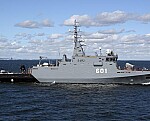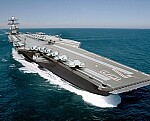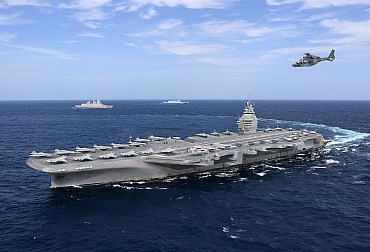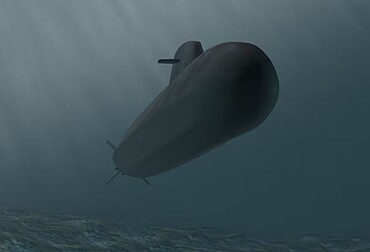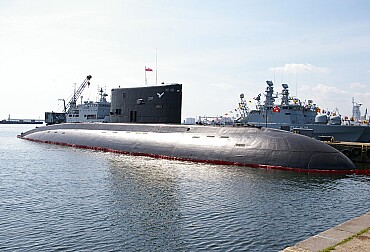The Spanish Navy plans to expand its fleet with an aircraft carrier similar to the French Charles de Gaulle
The Spanish Navy has launched a very ambitious modernization plan that will unfold over the next 25 years. The project aims to significantly strengthen the country's maritime power, with the purchase of an aircraft carrier inspired by the French Charles de Gaulle model. While some European navies, such as Italy's, are renewing their equipment, this plan represents a major turning point in Spain's desire to boost its military capabilities.

The navy currently operates the Juan Carlos I aircraft carrier
On June 25, the Spanish Navy's general staff officially presented this modernization project. The goal is simple: to acquire a conventionally powered aircraft carrier that can compete with those of the major naval powers. This project is part of an overall strategy to modernize the Spanish fleet by 2050. The navy currently operates the Juan Carlos I aircraft carrier and has a dozen EAV-8B Harrier II aircraft, nicknamed Matador. These aircraft, which are beginning to show their age, will need to be replaced before 2030, with Lockheed Martin's F-35B being the only viable successor. However, Madrid has not yet made a final decision on this major purchase.
Spain has committed to increasing its defense spending to 5% of GDP in response to NATO requirements. However, Prime Minister Pedro Sanchez has indicated that, for the time being, spending will remain at 2.1% of GDP—a decision that has drawn criticism from Donald Trump, among others. The navy's ambitions also include the construction of a future CATOBAR-configured aircraft carrier capable of accommodating up to 30 combat aircraft, which could include naval operations with drones. Although the exact type of catapults (steam or electromagnetic EMALS) has not yet been decided, the ship is expected to have a tonnage similar to that of the Charles de Gaulle, i.e. around 42,000 tons.
To carry out this highly ambitious project, feasibility studies have been entrusted to Navantia. At the same time, the Navy is considering the acquisition of a second Juan Carlos I-type aircraft carrier and must also consider replacing the AV-8B Matador aircraft. Several options are on the table for the aircraft that could operate aboard the future aircraft carrier: the Rafale Marine; the F-35C; or even a carrier-based version of the FCAS (Future Combat Air System), although the development of the latter remains uncertain.
As Spain has never owned a CATOBAR aircraft carrier, it will face several logistical challenges. Training pilots to operate these new aircraft will be a sensitive issue. In addition, Navantia does not yet have experience in building ships of such complexity. To fill this gap, cooperation with the United States and France is being considered. Collaboration with Turkey could also emerge as part of the MUGEN program to develop a STOBAR (Short Take-Off But Arrested Recovery) aircraft carrier of around 60,000 tons.
History of the Spanish aircraft carriers
Spain has operated two aircraft carriers in its naval history: Dédalo (R-01): Originally the USS Cabot, a U.S. Independence-class light aircraft carrier, it was transferred to Spain in 1967 and commissioned in 1968. It primarily operated helicopters and later Harrier jets, serving as Spain's first true aircraft carrier. It was decommissioned in 1989. And Príncipe de Asturias (R-11): Built by Spain and commissioned in 1988, this was a light aircraft carrier designed to operate V/STOL aircraft, primarily the AV-8B Harrier II. It served as the flagship of the Spanish Navy until its decommissioning in 2013.
Both were involved in several notable operations and exercises during their service. The Dédalo was a key asset in the Alpha Task Force, participating in numerous NATO exercises during the Cold War. These exercises focused on anti-submarine warfare, naval strike missions, and interoperability with NATO fleets, particularly in the Mediterranean. In 1978, the ship participated in a naval exercise off Cádiz, Spain, reconfigured as an assault carrier. A mock amphibious landing was conducted at Carboneras beach, showcasing its versatility in supporting amphibious operations. She teamed up with Spanish frigates (Baleares and Extremadura), destroyers (Lepanto and Roger de Lauria), and the USS Shark for ASW exercises off Cartagena, Spain. These drills focused on countering submarine threats, a key role for Dédalo’s helicopter air group. In January 1983 Dédalo’s helicopters also rescued eight crew members from the Polish cargo ship Kudowa Zdroj, which was sinking off Ibiza due to cargo shifting. This demonstrated its utility in search-and-rescue missions. In 1987–1988, during the transition to the Príncipe de Asturias, Dédalo served as a training platform for the new carrier’s air group, particularly for AV-8S Harrier pilots.
The Príncipe de Asturias and the Alpha Group were frequently deployed in support of NATO-led peace support operations during the Yugoslav Wars in the Adriatic Sea. These operations involved maritime security, enforcement of UN sanctions, and support for peacekeeping efforts in the Balkans. In 1991 she participated in the NATO Display Determination 91 Exercise alongside other carriers like USS Wasp, USS Forrestal, and HMS Invincible. The exercise focused on demonstrating NATO’s naval capabilities and interoperability in the Mediterranean. In 2004 she was deployed off the coast of Morocco for the Majestic Eagle 2004 multinational exercise, focusing on joint operations with allied navies, including live-fire exercises and air operations using its Harrier jets. The carrier regularly participated in NATO exercises to enhance interoperability and test its capabilities in sea control, anti-submarine warfare, and power projection. These included exercises with its Alpha Group, which was designed to operate as a cohesive combat unit. Príncipe de Asturias was decommissioned in 2013 due to high operating costs (approximately €100 million annually) and financial pressures on the Spanish government.



